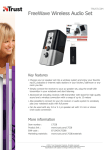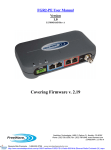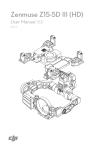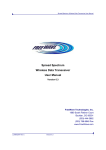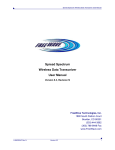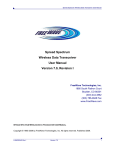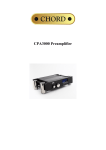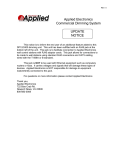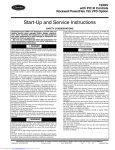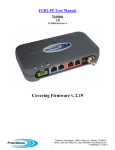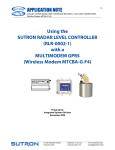Download FGRIO System User Manual
Transcript
FGRIO System User Manual Version 1 FGRIO Master FGRIO Slave FGR2-IO Slave FGRIO-M FGRIO-S FGR2-IOS-CE-U Remote Site Products - 1-888-532-2706 - www.remotesiteproducts.com http://www.remotesiteproducts.com/p-20029-FreeWave-FGRIO-S-Radio-Board-Level-900-MHz-I/O-Slave-Radio.aspx UL Notification: This equipment is suitable for use in Class I, Division 2, Groups A, B, C, and D or nonhazardous locations only.” Warning—Explosion Hazard—Substitution of components may impair suitability for Class I, Division 2. The diagnostics port and cable do not have a latching connector and cannot be used in a hazardous location. Remote Site Products - 1-888-532-2706 - www.remotesiteproducts.com http://www.remotesiteproducts.com/p-20029-FreeWave-FGRIO-S-Radio-Board-Level-900-MHz-I/O-Slave-Radio.aspx Table of Contents Description…………………………………………………………….….……….…………...5 Glossary …………………………………………………….….…………………………..5-6 Diagrams …..………………………………………….….……………………………...….7-8 LEDs ………………………………………………….….………………………...…………9 Set Up with Hyperterminal…..…………..………….…..……………...……………...….9-17 FGRIO Master………………………………..………....…………………………9-13 Operation Mode ………………………….…………….……………………..9 Call Book ..……...……………………………..………………….………...10 Radio Transmission Characteristics..……….…..……………….…………10 Max and Min Packet Sizes ………………...………………………...10 RF Data Rate ……………………...………………………………….10 Multipoint Parameters …………………...………………………………....10 Number of Repeaters……………...……………………………….....10 Network ID ………………………………………………………...….10 FGRIO Setup ...………………..…………………………………...……..11-13 IO Slave………………………………………….……………….……………….14-17 Operation Mode ………….………………………………………………….14 Call Book ……...……………………………………………………………..14 Radio Transmission Characteristics …………….………….……..……14-15 Max and Min Packet Sizes ……………………………………….14-15 RF Data Rate ………………………….………………………..…….15 Retry Timeout ………………………..………………………….……15 Multipoint Parameters ……………………..………………………….…….15 Number of Repeaters ………………..…………………….………….15 Network ID …………………………..………………………………..15 FGRIO Setup………………………..……………………...….……….....16-17 Set Up with Tool Suite………..…………..………..……………………………...………18-26 FGRIO Master…………………………..……………………………………..….18-21 Operation Mode ………………..……………………………………….…....18 Call Book……………………………………..……………………………….18 Radio Transmission Characteristics …………..…………………..…….….19 Max and Min Packet Sizes …………….……...……………………...19 RF Data Rate ……………………….………...……………………….19 Multipoint Parameters…………………………………...………………19-20 Number of Repeaters…………………………………...…………….19 Remote Site Products - 1-888-532-2706 - www.remotesiteproducts.com http://www.remotesiteproducts.com/p-20029-FreeWave-FGRIO-S-Radio-Board-Level-900-MHz-I/O-Slave-Radio.aspx Table of Contents Network ID…………………………………………………...……….19 IO Settings……………………………………………………...………...20-21 Enable FGRIO……………………………………………...……….. 20 Mapping……………………………………………….……...……….20 Time Out ……………………………………………..…...…………..21 Sensor Power………………………………………...………….…….21 IO Slave……………………………………………,,,…………………………….22-26 Operation Mode……….………………………...……………………..…….22 Call Book…………………………………...………………………………...22 Radio Transmission Characteristics………………….…………...………..23 Max and Min Packet Sizes ……………...……….………...………...23 RF Data Rate ……………………………………………...………….23 Retry Timeout ………………………………………..…..…………..23 Multipoint Parameters………………………………………..………….….24 Number of Repeaters………………………..……………..….……...24 Network ID……………………………………..………...…………...24 Wire Replacement…………………………………….………………….25-26 Digital Out 1 and Digital Out 2……………………….……………...25 Digital Def 1 and Digital Def 2……………………….………………25 Default Delay………………………………………………………….25 Digital Input Pull Up/Down…………………………….……...……..25 Installation………….…………………………………….……………………………….26-34 IO Slave……………………………………………..………………………...…..26-32 B+ …………………………………………… …………….……….……….26 1-5 Volt Sensor ……………………………..……………………………26-27 4-20 Milliamp Sensor …………………………………………… ….….27-28 1-5 Volt Sensor, Analog Input 3 or Analog Input 4…….…… …..…...28-30 Signal Levels and Accuracy……………………… ………...…......28 Signal Coupling for Analog Input 3 and Analog Input 4 ...…29-30 4-20 Milliamp Sensor, Analog Input 3 or Analog Input 4…… ……...30-31 Digital Input …………………………………….…………………..32 Digital Output …………………………… …..……………………………32 FGRIO Master ……………………………………..…… …………………….33-34 Rx, Tx, B+ ……………………………… …...…………………………..33 Analog Output ..….……………………………..………… ………………33 Remote Site Products - 1-888-532-2706 - www.remotesiteproducts.com http://www.remotesiteproducts.com/p-20029-FreeWave-FGRIO-S-Radio-Board-Level-900-MHz-I/O-Slave-Radio.aspx Table of Contents Digital Output …………………………………………….…………………33 Digital Input …………………………………….……………….………….23 Sensor Power………………………..……………………………………33-34 Link Alarms ………………………………………………………..………..34 Frequently Asked Questions ... …….……………………………….……….……….…34-35 Wiring Diagram …………………………………………………………………………….36 Specifications …………………………...……………………………………………….27-39 Remote Site Products - 1-888-532-2706 - www.remotesiteproducts.com http://www.remotesiteproducts.com/p-20029-FreeWave-FGRIO-S-Radio-Board-Level-900-MHz-I/O-Slave-Radio.aspx Description This is an addendum to the Spread Spectrum Wireless Data Transceiver User Manual. It covers details applicable specifically to using the FreeWave FGRIO Master and Slave modems. Please use this addendum in conjunction with the User Manual. The FreeWave Technologies FGRIO System provides outstanding performance and versatility in wireless transmission of process-control signals. FGRIO offers “transparent” acquisition, transport and reconstruction of analog, digital and power signals, eliminating the need for associated buried wiring. The RTU requires no altered programming. The FGRIO is Class 1 Div 2 approved and is lower-cost and provides better signal integrity than vulnerable wiring. The FGRIO System is based upon wireless RF Technologies. RF is subject to interference and communication interruptions. It should not be expected, therefore, to provide 100% communication, 100% of the time. The FGRIO System should not be used without proper provisions to ensure safety upon loss of radio communications. Glossary FGRIO Master– FreeWave wireless radio transceiver that operates as a Master for up to 4 FGRIO or FGR2-IO Slaves, and can operate as a Slave in a point to multipoint network. The FGRIO Master can receive over air a total of 4 analog input signals and 4 digital input signals from up to 4 FGRIO or FGR2-IO Slaves. It can also transmit up to 4 digital output signals over air to the FGRIO or FGR2-IO Slaves. The FGRIO Master does not operate as a Slave/ Repeater in the SCADA system. FGRIO Slave – FreeWave wireless radio transceiver that accepts up to a total of 4 input signals from sensors, then transmits these signals over air to the FGRIO Master. Two of the 4 available input signals can only be transmitted as analog signals and are labeled as Analog Input 1 and Analog Input 2 on the Slave’s terminal block. The other two input signals may be either analog or digital inputs, depending on the user’s needs. The FGRIO Slave can also receive over air 2 digital output signals and a sensor power control signal from the FGRIO Master. FGR2-IO Slave – New generation FreeWave wireless radio transceiver that accepts up to a total of 4 input signals from sensors, then transmits these signals over air to the FGRIO Master. Two of the available 4 input signals can only be transmitted as analog signals and are labeled as Analog Input 1 and Analog Input 2 on the Slave’s terminal block. The other two input signals may be either analog or digital inputs, depending on the user’s needs. The FGR2-IO Slave can also receive over air 2 digital output signals and a sensor power control signal from the FGRIO Master. The FGR2-IO has a line-of-sight range of 60 miles, compared to the 2 mile line-ofsight range of the FGRIO Slave. A note about terminology: The phrase ‘FGRIO System’, when used in this manual, will refer to any system that uses an FGRIO Master in conjunction with either FGRIO or FGR2-IO Slaves. IO Slave will refer to either an FGRIO Slave or an FGR2-IO Slave. Remote Site Products - 1-888-532-2706 - www.remotesiteproducts.com http://www.remotesiteproducts.com/p-20029-FreeWave-FGRIO-S-Radio-Board-Level-900-MHz-I/O-Slave-Radio.aspx Glossary (cont.) Analog Circuit– An electronic circuit that operates with currents and voltages that vary continuously with time and have no abrupt transitions between levels. Temperatures, pressures, or flow rates are all represented by analog circuits. Digital Circuit– An electronic circuit that functions as though currents or voltages exist only at one of a set of discrete levels, all transitions between levels being ignored. The states of a digital circuit are often referred to as on or off, high or low. VSNS- This is screw terminal # 7 on the IO Slave. This is an output used to power sensors/ transmitters. The maximum output voltage of this terminal is 20VDC for the FGRIO-S and 30VDC for the FGR2-IOS-C-U and FGR2-IOS-CE-U Remote Site Products - 1-888-532-2706 - www.remotesiteproducts.com http://www.remotesiteproducts.com/p-20029-FreeWave-FGRIO-S-Radio-Board-Level-900-MHz-I/O-Slave-Radio.aspx Diagrams Diagnostic Port Fig. 1 FGRIO Master Layer Terminal Block 10 pin Header FGRIO Master Terminal Block Ground Rx Data Tx Data B+ In Fig. 2 • • • • • • • • • • • • • • • • Sensor Power Digital Input 1 Digital Input 2 Digital Input 3 Digital Input 4 Analog Output 1 Analog Output 2 Analog Output 3 Analog Output 4 Digital Output 1 Digital Output 2 Digital Output 3 Digital Output 4 Link Alarm CMD Alarm Not Used Remote Site Products - 1-888-532-2706 - www.remotesiteproducts.com http://www.remotesiteproducts.com/p-20029-FreeWave-FGRIO-S-Radio-Board-Level-900-MHz-I/O-Slave-Radio.aspx Diagrams (cont.) Fig. 3 FGRIO/FGR2-IO Slave FGR2-IO-CE-U Pin #1 Terminal Block Connector Diagnostics Port DB9 Data port Terminal Block Connector Pin #1 Diagnostics Port 10 Pin Header Fig. 4 FGRIO Slave Terminal Block • • • • • • • • • • • • 12-Ground 11-B+ IN 10-Analog Input 2 9-Ground 8-Analog Input 1 7-VSNS/Analog Out 1 6-Ground 5-Digital Output 2 4-Digital Output 1 3-Ground 2-Digital Input 2 OR Analog Input 4* 1-Digital Input 1 OR Analog Input 3* FGR2-IO Slave Terminal Block • • • • • • • • • • • • 12-Ground 11-B+ IN 10-Analog Input 2 9-Ground 8-Analog Input 1 7-VSNS/Analog Out 1 6-Analog Output 2* 5-Digital Output 2 4-Digital Output 1 3-Ground 2-Digital Input 2 OR Analog Input 4* 1-Digital Input 1 OR Analog Input 3* Note: *Analog Output 2 is not available in the IO Wire Replacement mode. Analog Inputs 3 and 4 are 03.3VDC inputs. See wiring diagrams on pages 29-31 for details. Remote Site Products - 1-888-532-2706 - www.remotesiteproducts.com http://www.remotesiteproducts.com/p-20029-FreeWave-FGRIO-S-Radio-Board-Level-900-MHz-I/O-Slave-Radio.aspx LEDs The LEDs should have the following appearance when the IO Slave is linked to the FGRIO Master in a FGRIO Stand Alone Network: FGRIO Master FGRIO Slave Carrier Detect (CD) Transmit (TX) Clear to Send (CTS) Carrier Detect (CD) Transmit (TX) Clear to Send (CTS) Solid green bright Solid red dim BLINKING red Blinking green Blinking red Blinking red The LEDs on the FGRIO Master and IO Slave should have the following appearance when the FGRIO Master is linked to the FGR Network Master and the IO Slave is linked to the FGRIO Master: FGRIO Master FGRIO Slave Carrier Detect (CD) Transmit (TX) Clear to Send (CTS) Carrier Detect (CD) Transmit (TX) Clear to Send (CTS) Solid green bright Solid red dim FLICKERING red Blinking green Blinking red Blinking red Set Up with HyperTerminal FGRIO Master– In order for the FGRIO System to function properly, the following settings must be programmed. For all other settings not listed below, please refer to the User Manual. (0) Operation Mode (3) Point to MultiPoint Slave– Choose this setting when the FGRIO System is being integrated into an FGR Serial Network. The IO functionality is turned on in Menu 9– FGRIO Set Up, in HyperTerminal. Note: Setting (E), FGRIO Master, should only be selected when the FGRIO System is operating independently of an FGR FreeWave Network. Fig. 5 Use this Operation Mode when the FGRIO Master is being integrated into an FGR Serial Network Use this Operation Mode when the FGRIO System is Stand Alone Remote Site Products - 1-888-532-2706 - www.remotesiteproducts.com http://www.remotesiteproducts.com/p-20029-FreeWave-FGRIO-S-Radio-Board-Level-900-MHz-I/O-Slave-Radio.aspx Set Up with HyperTerminal (cont.) FGRIO Master (2) Call Book– IO Slaves’ serial numbers must be programmed in the FGRIO Master’s Call Book. In addition, the Network ID must be set to the same ID as the rest of the network. Programming both the Call Book and Network ID settings is unique to the FGRIO System and must be done for both integrated and stand alone applications. (3) Radio Transmission Characteristics (1) Max Packet Size and (2) Min Packet Size– The FGRIO System requires a minimum combined packet size of 48 Bytes. The following is a list of the available packet sizes that can be used. Fig. 6 Combined Packet Size Definition with RF Date Rate of 3 Max Setting Min Setting 0 1 2 3 4 5 6 7 8 9 0 8 24 40 56 72 88 104 120 136 152 1 12 28 44 60 76 92 108 124 140 156 2 16 32 48 64 80 96 112 128 144 160 3 20 36 52 68 84 100 116 132 148 164 4 24 40 56 72 88 104 120 136 152 168 5 28 44 60 76 92 108 124 140 156 172 6 32 48 64 80 96 112 128 144 160 176 7 36 52 68 84 100 116 132 148 164 180 8 40 56 72 88 104 120 136 152 168 184 9 44 60 76 92 108 124 140 156 172 188 (4) RF Data Rate– The RF Data Rate must be set to 3 when using the FGRIO System. This is for applications that are stand alone or when integrated into an existing FGR network. MultiPoint Parameters(0) Number Repeaters– This setting must be set to 1 for all FGR and IO radios in the Network. (6) Network ID– In addition to entering the IO Slaves’ serial numbers in the Call Book, the Network ID being used for the Network must be set from 1-4095. (Do NOT use 255). Programming both the Call Book and Network ID settings is unique to the FGRIO System and must be done for both integrated and stand alone applications. Note: The FGRIO Master does not function as a Slave/Repeater in the SCADA network. Remote Site Products - 1-888-532-2706 - www.remotesiteproducts.com http://www.remotesiteproducts.com/p-20029-FreeWave-FGRIO-S-Radio-Board-Level-900-MHz-I/O-Slave-Radio.aspx Set Up with HyperTerminal (cont.) FGRIO Master (9) FGRIO Setup– Outputs on the FGRIO Master are mapped to inputs on the IO Slave. Fig. 7 Remote Site Products - 1-888-532-2706 - www.remotesiteproducts.com http://www.remotesiteproducts.com/p-20029-FreeWave-FGRIO-S-Radio-Board-Level-900-MHz-I/O-Slave-Radio.aspx Set Up with HyperTerminal (cont.) FGRIO Master (9) FGRIO Setup (cont.) (0) FGRIO – Must be set to 1 to enable I/O functions. (1) to (8) – To map the FGRIO Master outputs to the correct IO Slave inputs, use the following steps: 1) Select which IO Slave you are mapping to the FGRIO Master. Note the Master’s Call Book Entry # that lists this IO Slave’s serial number. 2) Next, determine which analog or digital input from the IO Slave radio you wish to map to the FGRIO Master. This could be Analog Input(AI)#1, AI#2, AI#3, AI#4, or Digital Input(DI)#1, or DI#2, depending on which sensor(s) the Slave will be connected to. 3) Using the following table, find the intersection between the Master’s Call Book Entry # (found in step 1) and the selected input from the Slave (found in step 2). Note the number listed at this intersection. 4) Go to Menu 9, FGRIO Setup (Figure 7). Select which Master’s output you would like to “connect” to the input from the Slave. At the flashing curser, enter the number to the left of the selected output. Next enter the number found in step 3. This number should be displayed to the right of the selected output. Fig. 8 AI#1 AI#2 AI#3 AI#4 DI#1 DI#2 FRGIO-M Call Book Entry #0 1 2 9 10 1 2 FRGIO-M Call Book Entry #1 3 4 11 12 3 4 FRGIO-M Call Book Entry #2 5 6 13 14 5 6 FRGIO-M Call Book Entry #3 7 8 15 16 7 8 EXAMPLE To map Analog Output 1 of the FGRIO Master to Analog Input 2 of the IO Slave (serial # 9300004), entry (5) in the FGRIO Setup menu will have a value of 2. This is calculated by first checking the Call Book entry # of IO Slave #930-0004 (See Figure 9, next page). The entry # is 0. Next, go to the table above, find call book entry # 0, then go to the column for IO Slave Analog Input #2. The value listed is 2. A 2 will be entered for Analog Output #1 of the FGRIO Master. Remote Site Products - 1-888-532-2706 - www.remotesiteproducts.com http://www.remotesiteproducts.com/p-20029-FreeWave-FGRIO-S-Radio-Board-Level-900-MHz-I/O-Slave-Radio.aspx Set Up with HyperTerminal (cont.) FGRIO Master Fig. 9 (9) FGRIO Setup (cont.) (9) TimeOut– 0-255. This setting determines the amount of time to wait before issuing a Link Alarm due to loss of communication between the FGRIO Master and IO Slave. A setting of 1 = 1/6 second 6 = 1 second 42 = 7 seconds 252 = 42 seconds (A) Sensor Power– 0 or 1. A setting of 0 supplies continuous power to the sensor at the IO Slave. A setting of 1, “Gated”, is used when the RTU provides a switched power output to control powering the sensors at the IO Slave and analog outputs of the FGRIO Master on and off. Remote Site Products - 1-888-532-2706 - www.remotesiteproducts.com http://www.remotesiteproducts.com/p-20029-FreeWave-FGRIO-S-Radio-Board-Level-900-MHz-I/O-Slave-Radio.aspx Set Up With HyperTerminal (cont.) IO Slave- In order for the FGRIO System to function properly, the following settings must be programmed. For all other settings not listed below, please refer to the User Manual. (0) Operation Mode (E) FGRIO Slave Fig. 10 (2) Call Book– The FGRIO Master’s serial number must be programmed as entry #0 in the IO Slave’s Call Book. Set “Entry to Call” to 0. In addition, the Network ID must be set to the same ID as the rest of the network. Programming both the Call Book and Network ID settings is unique only to the FGRIO System and must be done for both integrated and stand alone applications. (3) Radio Transmission Characteristics (1) Max Packet Size and (2) Min Packet Size– The FGRIO System requires a minimum combined packet size of 48 Bytes. The following is a list of the available packet sizes that can be used (Figure 11, next page). Remote Site Products - 1-888-532-2706 - www.remotesiteproducts.com http://www.remotesiteproducts.com/p-20029-FreeWave-FGRIO-S-Radio-Board-Level-900-MHz-I/O-Slave-Radio.aspx Set Up with HyperTerminal (cont.) IO Slave (3) Radio Transmission Characteristics (cont.) Fig. 11 Combined Packet Size Definition with RF Date Rate of 3 Max Setting Min Setting 0 1 2 3 4 5 6 7 8 9 0 8 24 40 56 72 88 104 120 136 152 1 12 28 44 60 76 92 108 124 140 156 2 16 32 48 64 80 96 112 128 144 160 3 20 36 52 68 84 100 116 132 148 164 4 24 40 56 72 88 104 120 136 152 168 5 28 44 60 76 92 108 124 140 156 172 6 32 48 64 80 96 112 128 144 160 176 7 36 52 68 84 100 116 132 148 164 180 8 40 56 72 88 104 120 136 152 168 184 9 44 60 76 92 108 124 140 156 172 188 (4) RF Data Rate– The RF Data Rate must be set to 3 when using the FGRIO System. This is for applications that are stand alone or when integrated into an existing FGR network. (8) Retry Timeout– By lowering the Retry Timeout, the inactive link time between the FGRIO Master and IO Slave can be reduced when going from autonomous mode to connecting back to the FGR Network. If the Network Master goes down, the FGRIO Master and Slave will continue to operate in autonomous mode. When the Network Master comes back up, the FGRIO Master will break the link with the IO Slave to reestablish a link with the Network Master. Once the FGRIO Master is linked to the Network Master, then the IO Slave will be able to link back to the FGRIO Master. With a lower Retry Timeout setting, it will take less time for the IO Slave to link to the FGRIO Maser. (5) MultiPoint Parameters(0) Number Repeaters- This setting must be set to 1 for all FGR and IO radios in the Network. (6) Network ID– In addition to entering the FGRIO Master’s serial number in the Call Book, the Network ID being used for the Network must be set from 1-4095 (Do NOT use 255). Use the same Network ID for the IO Slave as was used for the FGRIO Master. Programming both the Call Book and Network ID settings is unique to the FGRIO System and must be done for both integrated and stand alone applications. Remote Site Products - 1-888-532-2706 - www.remotesiteproducts.com http://www.remotesiteproducts.com/p-20029-FreeWave-FGRIO-S-Radio-Board-Level-900-MHz-I/O-Slave-Radio.aspx Set Up with HyperTerminal (cont.) IO Slave (9) FGRIO Setup (0) Default Delay, the value set is in .28 second units. This sets the time duration that will pass, after a loss of communication, before the radio enters default condition. e.g. A value of 36 = 36*0.28 seconds = 10.08 seconds. (1) Digital Out1– Select the desired FGRIO Master Digital Input # (1-4) to control the IO Slave Digital Output # 1. (2) Digital Out2– Select the desired FGRIO Master Digital Input # (1-4) to control the IO Slave Digital Output # 2. (3) Digital Def 1 – Select the desired IO Slave Output Default at power-on and link failure. 0= Open Drain output ON (Conducting to GND, 2 Amps max) 1= Open Drain output OFF (Non-Conducting) 2= Make no change in state. (4) Digital Def2- Select the desired IO Slave Output Default at power-on and link failure. 0= Open Drain output ON (Conducting to GND, 2 Amps max) 1= Open Drain output OFF (Non-Conducting) 2= Make no change in state. Note: If programming a DO to turn on after loss of link, ensure that the energized device can sustain the state undamaged in case the loss in lengthy. (5) IO Modbus– This menu option must be set to “Disabled” when using a FGRIO network configuration. (E and F) DI1 Pull Up/Down- Options E and F control power-up states of the internal resistor (10Kohms) connected to the DIs. They can pull up, such as when using a closed-contactto-GND switch input, pull down so that unused inputs read “0” as DIs or ~0 as auxiliary analogs, or float to not load analog inputs. (I and J) AI(DI1) and AI(DI2) Filter do not apply in the FGRIO network. Note: Both of the IO Slave Digital Outputs may be driven by the same FGRIO Master Input. Remote Site Products - 1-888-532-2706 - www.remotesiteproducts.com http://www.remotesiteproducts.com/p-20029-FreeWave-FGRIO-S-Radio-Board-Level-900-MHz-I/O-Slave-Radio.aspx Set Up with HyperTerminal (cont.) (9) FGRIO Setup (cont.) Fig. 12 Remote Site Products - 1-888-532-2706 - www.remotesiteproducts.com http://www.remotesiteproducts.com/p-20029-FreeWave-FGRIO-S-Radio-Board-Level-900-MHz-I/O-Slave-Radio.aspx Set Up with Tool Suite FGRIO Master– In order for the FGRIO System to function properly, the following settings must be programmed. For all other settings not listed below, please refer to the User Manual. 0) Set Operation Mode Tab-(Figure 13) Point to MultiPoint Slave– Choose this setting when the FGRIO System is being integrated into an FGR FreeWave Network. The IO functionality is turned on under the IO Settings tab. Note: Setting (E), FGRIO Master, should only be selected when the FGRIO System is operating independently of an FGR FreeWave Network. Figure 13 2) Call Book TabEnter the serial number for each IO Slave, for a maximum of up to four (4) IO-Slave Radios. Remote Site Products - 1-888-532-2706 - www.remotesiteproducts.com http://www.remotesiteproducts.com/p-20029-FreeWave-FGRIO-S-Radio-Board-Level-900-MHz-I/O-Slave-Radio.aspx Set Up with Tool Suite (cont.) 3) Radio Transmission Characteristics Tab-(Figure 14) Max Packet Size and Min Packet Size– The FGRIO System requires a minimum combined packet size of 48 Bytes. See Figure 6 (pg. 10) for a list of available packet sizes. RF Data Rate– The RF Data Rate must be set to “Normal” (3) when using the FGRIO System. This is for applications that are stand alone or when integrated into an existing FGR network. Figure 14 Figure 14 5) MultiPoint Parameters Tab– (Figure 15) Number Repeaters– This setting must be set to 1 for all FGR and FGRIO radios in the Network. Network ID– In addition to entering the serial numbers of the IO Slaves in the Call Book, the Network ID being used for the Network must be set from 1-4095 (Do NOT use 255). Programming both the Call Book and Network ID settings is unique to the FGRIO System and must be done for both integrated and stand alone applications. Note: The FGRIO Master does not function as a Slave/Repeater in the SCADA network. Remote Site Products - 1-888-532-2706 - www.remotesiteproducts.com http://www.remotesiteproducts.com/p-20029-FreeWave-FGRIO-S-Radio-Board-Level-900-MHz-I/O-Slave-Radio.aspx Set Up with Tool Suite (cont.) 5) MultiPoint Parameters Tab (cont.) Figure 15 FGRIO Master (9) IO Settings Tab- (Figure 16). This tab allows the user to map the inputs of the IO-Slave to the outputs of the FGRIO-Master. Enable FGRIO– To turn on the IO functionality in the FGRIO-M, the “Enable FGRIO” drop down box must be set to enabled. Mapping– In the IO Settings tab of the FGRIO-M, the FGRIO-M outputs are mapped to the IO-Slave inputs. To map, select the appropriate Slave input from the drop down box next to the master’s output. Note: The slaves are labeled by their position in the masters Call Book. E.g. Slave 0 refers to the serial number in entry to call 0. Remote Site Products - 1-888-532-2706 - www.remotesiteproducts.com http://www.remotesiteproducts.com/p-20029-FreeWave-FGRIO-S-Radio-Board-Level-900-MHz-I/O-Slave-Radio.aspx Set Up with Tool Suite (cont.) FGRIO Master (9)IO Settings Tab– (cont.) Time Out– 0-255. This setting determines the amount of time to wait before issuing a Link Alarm due to loss of communication between the FGRIO Master and IO Slave. A setting of 1 = 1/6 second 6 = 1 second 42 = 7 seconds 252 = 42 seconds Sensor Power– Always On or Gated. A setting of Always On supplies continuous power to the sensor at the IO Slave. A setting of Gated, is used when the RTU provides a switched power output to control powering the sensors at the IO Slave and analog outputs of the FGRIO Master on and off. Figure 16 Remote Site Products - 1-888-532-2706 - www.remotesiteproducts.com http://www.remotesiteproducts.com/p-20029-FreeWave-FGRIO-S-Radio-Board-Level-900-MHz-I/O-Slave-Radio.aspx Set Up with Tool Suite (cont.) IO Slave- In order for the FGRIO System to function properly, the following settings must be programmed. For all other settings not listed below, please refer to the User Manual. Set Operation Mode Tab- (Figure 17) (E) FGRIO Slave– The modem mode of (E) IO-Slave (NOT IO-MODBUS) must be used in the FGRIO System. Figure 17 (2) Call Book– The FGRIO Master’s serial number must be programmed as entry #0 in the IO Slave’s Call Book. Set “Entry to Call” to 0. In addition, the Network ID must be set to the same ID as the rest of the network. Programming both the Call Book and Network ID settings is unique to the FGRIO System and must be done for both integrated and stand alone applications. Remote Site Products - 1-888-532-2706 - www.remotesiteproducts.com http://www.remotesiteproducts.com/p-20029-FreeWave-FGRIO-S-Radio-Board-Level-900-MHz-I/O-Slave-Radio.aspx Set Up with Tool Suite (cont.) IO Slave Transmission Characteristics-(Figure 18) Max Packet Size and Min Packet Size– The FGRIO System requires a minimum combined packet size of 48 Bytes. See Figure 6 (pg. 10) for a list of available packet sizes that can be used. RF Data Rate - The RF Data Rate must be set to “Normal” (3) when using the FGRIO System. This is for applications that are stand alone or when integrated into an existing FGR network. Retry Timeout– By lowering the Retry Timeout, the inactive link time between the FGRIO Master and IO Slave can be reduced when going from autonomous mode to connecting back to the FGR Network. If the Network Master goes down, the IO Master and Slave will continue to operate in autonomous mode. When the Network Master comes back up, the FRGIO Master will break the link with the IO Slave to reestablish a link with the Network Master. Once the FGRIO Master is linked to the Network Master, then the IO Slave will be able to link back to the FGRIO Master. With a lower Retry Timeout setting, it will take less time for the IO Slave to link to the FGRIO Master. Figure 18 Remote Site Products - 1-888-532-2706 - www.remotesiteproducts.com http://www.remotesiteproducts.com/p-20029-FreeWave-FGRIO-S-Radio-Board-Level-900-MHz-I/O-Slave-Radio.aspx Set Up with Tool Suite (cont.) MultiPoint Parameters Tab-(Figure 19) Number Repeaters- This setting must be set to “On” for all FGR and IO radios in the Network. Network ID– In addition to entering the FGRIO Master’s serial number in the Call Book, the Network ID being used for the Network must be set from 1-4095. (Do NOT use 255). Programming both the Call Book and Network ID settings is unique to the FGRIO System and must be done for both integrated and stand alone applications. Figure 19 Remote Site Products - 1-888-532-2706 - www.remotesiteproducts.com http://www.remotesiteproducts.com/p-20029-FreeWave-FGRIO-S-Radio-Board-Level-900-MHz-I/O-Slave-Radio.aspx Set Up with Tool Suite (cont.) IO Slave (9) Wire Replacement Tab (Figure 20) Digital Out 1 – Select the desired FGRIO Master Digital Input # (1-4) to control the IO Slave Digital Output # 1. Digital Out 2– Select the desired FGRIO Master Digital Input # (1-4) to control the IO Slave Digital Output # 2. Digital Out 1 Default – Select the desired IO Slave Output Default at power-on and link failure. Open Drain output ON (Conducting to GND, 2 Amps max) Open Drain output OFF (Non-Conducting) Make no change in state. Digital Out 2 Default - Select the desired IO Slave Output Default at power-on and link failure. Open Drain output ON (Conducting to GND, 2 Amps max) Open Drain output OFF (Non-Conducting) Make no change in state. Note: If programming a DO to turn on after loss of link, ensure that the energized device can sustain the state undamaged in case the loss in lengthy. Default Delay - This value is set in .28 second units. This sets the time duration that will pass, after a loss of communication, before the radio enters default condition. E.g. A value of 36 = 36*0.28 seconds = 10.08 seconds. DI1 Pull Up/Down– These options control power-up states of the internal resistor (10Kohms) connected to the DIs. They can pull up, such as when using a closed-contact-toGND switch input, pull down so that unused inputs read “0” as DIs or ~0 as auxiliary analogs, or float to not load analog inputs. Note: Both of the IO Slave Digital Outputs may be driven by the same FGRIO Master Input. Remote Site Products - 1-888-532-2706 - www.remotesiteproducts.com http://www.remotesiteproducts.com/p-20029-FreeWave-FGRIO-S-Radio-Board-Level-900-MHz-I/O-Slave-Radio.aspx Set Up with Tool Suite (cont.) Figure 20 Installation IO Slave (1) B+ IN Screw Terminal #11 (B+ In) on the terminal block of the IO Slave is the raw power for the radio. This terminal is directly connected to Pin # 1 on the 10 pin white header of the IO Slave. Either one can be used to power the radio. (2) 1-5 Volt Sensor • For connection to either Analog Input 1 or Analog Input 2, the 1-5 volt sensor can be wired to the IO Slave with a 3 wire connection. • The Sensor Ground Wire can be connected to Ground Screw Terminal #3, 9, or 12 on the terminal block of the IO Slave. •The Sensor Power Wire is connected to the VSNS screw terminal #7 on the terminal block of the IO Slave. Rated total current draw from VSNS is 40 mA or less. •Sensor Output Wire is connected to Analog Input 1 screw terminal #8 or Analog Input 2 screw terminal #10 on the terminal block of the IO Slave. Remote Site Products - 1-888-532-2706 - www.remotesiteproducts.com http://www.remotesiteproducts.com/p-20029-FreeWave-FGRIO-S-Radio-Board-Level-900-MHz-I/O-Slave-Radio.aspx Installation IO Slave (2) 1-5 Volt Sensor (cont.) • Sensor Output Wire is connected to Analog Input 1 screw terminal # 8 or Analog Input 2 screw terminal # 10 on the terminal block of the IO Slave. (3) 4-20 Milliamp Sensor (Figures 21-22) • Consists of a 2 wire connection from the Sensor to the IO Slave. • An external resistor (typically 249 Ohms) is required to convert 4-20 milliamps to 15 volts. The resistor goes from the desired Analog Input to Ground screw terminals on the terminal block of the IO Slave. • Sensor Power Supply (High) Wire is connected to VSNS screw terminal #7 on the terminal block of the IO Slave. • Sensor Output (Low) Wire is connected to the same Analog Input as the resistor on the terminal block of the IO Slave. Example of one 4-20 milliamp sensors connecting to the terminal block of the IO Slave: (Figures 21-22) Figure 21 FGRIO-S Wiring diagram Low Wire Sensor #1 High Wir Resistor for Sensor # 1 e Resistor for Sensor # 2 Low Wire Sensor #2 High W ire • • • • • • • • • • • • 12-Ground 11-B+ IN 10-Analog Input 2 9-Ground 8-Analog Input 1 7-VSNS 6-Ground 5-Digital Output 2 4-Digital Output 1 3-Ground 2-Digital Input 2 OR Analog Input 4* 1-Digital Input 1 OR Analog Input 3* Remote Site Products - 1-888-532-2706 - www.remotesiteproducts.com http://www.remotesiteproducts.com/p-20029-FreeWave-FGRIO-S-Radio-Board-Level-900-MHz-I/O-Slave-Radio.aspx Installation (cont.) Figure 22 FGR2-IOS Wiring diagram Low Wire Sensor #1 Hig hW ire Resistor for Sensor # 1 Resistor for Sensor # 2 Low Wire Sensor #2 High Wire • • • • • • • • • • • • 12-Ground 11-B+ IN 10-Analog Input 2 9-Ground 8-Analog Input 1 7-VSNS/Analog Out 1 6-Analog Output 2* 5-Digital Output 2 4-Digital Output 1 3-Ground 2-Digital Input 2 OR Analog Input 4* 1-Digital Input 1 OR Analog Input 3* Note: *Analog Output 2 is not available in the IO Wire Replacement mode. Analog inputs 3 and 4 are 0-3.3VDC inputs. See wiring diagrams on pages 29-31 for details. (3) 1-5 Volt Sensor, Analog Input 3 or Analog Input 4 With FGRIO-S firmware 2.65IO or FGR2-IOS firmware 9.7, and FGRIO-M firmware 2.65, the Digital Inputs (DIs) of the FGRIO-S or FGR2-IOS may be digitized to 10 bit resolution and mapped to Analog Outputs (AOs) on the FRGIO-M. This allows up to 4 analog transducers to be connected to a single remote FGRIO-S or FGR2-IOS radio. A. Signal Levels and Accuracy. The existing AIs at screw terminal #8 and screw terminal #10 are usable with .1V to 5.625V input voltages (compatible with most 1-5V and 4-20mA transmitters) and load the input with about 100Kohm to GND. They also offer accuracy of +/-.1% with 16 bit resolution and are therefore recommended for the most critical variables in a system. In comparison, the new AIs formed from the DIs at screw terminal #1 and screw terminal #2 are directly usable with signals only from .1V to 2.812V in wire replacement mode. Input loading can be selected as 10Kohm to GND or unloaded (>1Megohm). Accuracy is within +/-.25% and resolution is 10 bits. The next section describes methods to best apply inputs to them. Remote Site Products - 1-888-532-2706 - www.remotesiteproducts.com http://www.remotesiteproducts.com/p-20029-FreeWave-FGRIO-S-Radio-Board-Level-900-MHz-I/O-Slave-Radio.aspx Installation (cont.) B. Signal Coupling for Analog Input 3 and Analog Input 4. 1) Input Resistor The IO Slave DIs have always provided an internal 10Kohm resistor pull-up to the radio’s 3.3V logic supply. With new firmware 2.65IO in the FGRIO-S, or 9.7 in the FGR2-IOS, the resistor can also be commanded (in the FGRIO Setup menu) to pull down to GND or “float” unconnected. As will be shown, these options are useful for connection of analog inputs. 2) Signal Level Reduction. As stated above, the DI does not have sufficient voltage range for direct connection to typical transducer outputs, so the input must be restricted. For signal replication, it is assumed the input signal level will be halved, and the measured value sent to the FGRIO-M doubled, to achieve an overall 1:1 signal reproduction. 3) VSNS Sensor Power The switched voltage source at screw terminal #7 is designed to drive only two 4-20mA transmitters to full scale. Voltage output (1-5V) transmitters usually consume less current and may allow up to 4 to be switched. Below are two diagrams showing the connection of a 1-5V sensor to Analog Input 3: (Figures 23 and 24) Figure 23 Remote Site Products - 1-888-532-2706 - www.remotesiteproducts.com http://www.remotesiteproducts.com/p-20029-FreeWave-FGRIO-S-Radio-Board-Level-900-MHz-I/O-Slave-Radio.aspx Installation (cont.) Figure 24 (4) 4-20 Milliamp Sensor, Analog Input 3 or Analog Input 4 The same accuracy and signal level reduction considerations stated under section (3) 1-5 Volt Sensor, Analog Input 3 or Analog Input 4, apply when using a 4-20 milliamp sensor. The switched voltage source at screw terminal #7 is designed to drive only two 4-20mA transmitters to full scale. If a system will use more than two, the additional transmitters must be powered from a separate supply, such as directly from the battery or another DC supply. On the next page are two diagrams showing the connection of a 4-20 milliamp sensor to Analog Input 3 (Figures 25 and 26): Remote Site Products - 1-888-532-2706 - www.remotesiteproducts.com http://www.remotesiteproducts.com/p-20029-FreeWave-FGRIO-S-Radio-Board-Level-900-MHz-I/O-Slave-Radio.aspx Installation (cont.) (4) 4-20 Milliamp Sensor, Analog Input 3 or Analog Input 4 Figure 25 Figure 26 Remote Site Products - 1-888-532-2706 - www.remotesiteproducts.com http://www.remotesiteproducts.com/p-20029-FreeWave-FGRIO-S-Radio-Board-Level-900-MHz-I/O-Slave-Radio.aspx Installation (cont.) IO Slave (5) Digital Input • Switch Output Wire is connected to Digital Input 1 screw terminal # 1 or Digital Input 2 screw terminal # 2 on the terminal block of the IO Slave. • Switch Ground Wire is connected to Ground screw terminal # 3, 9 or 12 on the terminal block of the IO Slave. If the Switch Ground Wire is not returned to the IO Slave, the potential difference between the IO Slave Ground and the Dry Contact Closure (Switch) Ground should not exceed 1 Volt. • In the case of a 3 wire digital transducer, set up similarly to the 1-5V analog sensor, except with the signal wire connected to a Digital Input. (6) Digital Output • Digital Output is an open drain field effect transistor connected to Ground. It connects to Ground when zero volts is connected to the controlling Master Digital Input. • The current rating for Digital Output is 2 amps or less. The Digital Output will selfprotect if a current of more than 2 1/2 amps is drawn and automatically retry at .16 second intervals. • If power on the Solenoid (end device) is not driven from the same power supply as the IO Slave, that source must be equal to or less than the IO Slave power supply voltage. Within the IO Slave, a 3 amp rated Schottky Diode is connected from each Digital Output to the radio power supply terminal for clamping the Solenoid fly back current. If the relay supply voltage exceeded the radio supply voltage, then current would flow through that diode back to the radio, preventing coil current from shutting off and potentially causing an overvoltage condition. Typical set up of Digital Output wiring between Solenoid and IO Slave: Solenoid Digital Output 1 Solar Panel/ Battery Vo GND B+ GND Terminal Block of IO Slave Remote Site Products - 1-888-532-2706 - www.remotesiteproducts.com http://www.remotesiteproducts.com/p-20029-FreeWave-FGRIO-S-Radio-Board-Level-900-MHz-I/O-Slave-Radio.aspx Installation (cont.) FGRIO Master (1) Rx, Tx, B+ • Receive, Transmit, and Power are available on screw terminals of the FGRIO Master terminal block as well as the 10 pin header. (2) Analog Output • The Analog Output wire is connected from the Analog Output 1,2,3 or 4 screw terminal on the FGRIO Master terminal block to the Analog Input of the RTU (destination device). • Common Ground is required. It is recommended to run a Ground wire from an FGRIO Master Ground screw terminal to Ground on the RTU. NOTE: Analog Output is 1-5 V at low current, so any 4-20 mA current sensing resistor on the RTU MUST BE REMOVED. If in doubt as to whether RTU-internal resistors are active, test the link with a full scale input. (3) Digital Output • The Digital Output wire is connected from the Digital Output 1,2,3 or 4 screw terminal on the FGRIO Master terminal block to the Digital Input of the RTU (destination device). • Common Ground is required. It is recommended to run a Ground wire from the FGRIO Master Ground screw terminal to Ground on the RTU. NOTE: The Digital Output actively drives Low (.4V) and High (4.0V). Remove any RTU input pull-up resistor, if less than 10 K ohms. Verify that signal levels meet the RTU input requirements after connection to the RTU. (4) Digital Input • The RTU Digital Output Wire is connected to Digital Input 1,2,3 or 4 screw terminal on the terminal block of the FGRIO Master. An internal 10Kohm pullup to +5V is provided. • The RTU Ground Wire is connected to any of the Ground screw terminals on the terminal block of the FGRIO Master. Some RTUs use isolated I/O and may require a ground connection for each input and output. (5) Sensor Power • To minimize power drain of the IO Slave Solar/Battery System, an input terminal called Sensor Power is provided on the FGRIO Master terminal block. Sensor Power has an internal 10 Kohm pull-down to Ground. • If the RTU provides a switched sensor power output, connect it to this terminal. Verify that the level at Sensor Power falls to < 1.0 V when de-asserted to ensure the slaves will mirror. If not, connect additional pull-down resistance externally. Remote Site Products - 1-888-532-2706 - www.remotesiteproducts.com http://www.remotesiteproducts.com/p-20029-FreeWave-FGRIO-S-Radio-Board-Level-900-MHz-I/O-Slave-Radio.aspx Installation (cont.) FGRIO Master (5) Sensor Power (cont.) • The state of that sensor power will be mirrored at the IO Slave, powering the sensors at the IO Slave on and off. It is necessary to change FGRIO Setup sub menu (A) to “1” (Gated). NOTE: The sensor power terminal both activates sensor power at the controlled IO Slaves, and activates Analog Outputs at the FGRIO Master interface board, when in Sensor Power “Gated” mode. (6) Link Alarms • Link Alarm 1 is an alarm reflecting loss of communication on any path. A wire is run from the Link Alarm 1 screw terminal to the Link Alarm screw terminal on the RTU. • Link Alarm 2 (CMD Alarm) indicates that a Digital Output or Sensor Power command was not carried out due to an over-current fault. A wire is run from the Link Alarm 2 screw terminal to the Link Alarm screw terminal on the RTU. NOTE: The terminal block of the FGRIO Master and Slave can accept a single wire up to 16 gauge. Smaller wire is required for 2 wires, or wire + resistor into the same screw terminal. Frequently Asked Questions Q: Can IO be used with a 1 watt radio? A: The FGRIO Master operates as a standard FGR 1 watt radio with a 60 mile line of sight range. The FGRIO Slave functions as an FGR radio with a 2 mile line of sight range. The FGR2-IO Slave functions as an FGR radio with a 60 mile line of sight. Q: Can the IO radios be repeated through our other radios to extend the range? A: From the IO Slave to the FGRIO Master, repeaters cannot be used. From the FGRIO Master to the rest of the existing network, repeaters can be used as they already are in existing FreeWave networks. The FGRIO Master will not function as a Slave/Repeater Q: Can the FGRIO Master operate as Slave/Repeater in the overall network? A: The FGRIO Master currently does not have the capability to operate as a Slave/Repeater. It does function as the Master to the IO Slave, and as a Slave to the rest of the network. Remote Site Products - 1-888-532-2706 - www.remotesiteproducts.com http://www.remotesiteproducts.com/p-20029-FreeWave-FGRIO-S-Radio-Board-Level-900-MHz-I/O-Slave-Radio.aspx Frequently Asked Questions Q: Can data be sent directly from the IO Slave to the Master of the FreeWave network? A: No. The FGRIO system functions as wire replacement only. The IO Slave does not have the capability of transmitting data directly to the Master of the network. Q: What are the sizes of the FGRIO Master and Slave? A: The board level IO Slave has the same footprint as the FGRO9 family. The board level IO Slave dimensions are 127 mm (L) x 61 mm (W) x 15.5 mm (H). The FGRIO Master is a standard footprint FGRO9 plus an IO Interface board on top, differing only in width at 2.75 inches. The dimensions of the FGRIO Master are 140 mm (L) x 70 mm (W) x 34 mm (H). Q: What timing issues does IO introduce? A: Although IO mimics a wired connection, the electronics and communication heartbeat do cause some signal delay. The worst case delay for digital signals in either direction and the Sensor Power command from FGRIO Master to IO Slave is 167 msec, assuming a robust link. Worst case delay from FGRIO Master Sensor Power assertion to FGRIO Master Analog Output refresh is 700 msec. Remote Site Products - 1-888-532-2706 - www.remotesiteproducts.com http://www.remotesiteproducts.com/p-20029-FreeWave-FGRIO-S-Radio-Board-Level-900-MHz-I/O-Slave-Radio.aspx Remote Site Products - 1-888-532-2706 - www.remotesiteproducts.com http://www.remotesiteproducts.com/p-20029-FreeWave-FGRIO-S-Radio-Board-Level-900-MHz-I/O-Slave-Radio.aspx B+ GND Terminal Block of FGRIO Master Screw Terminal # 12 Not Used RTU Analog Output wire connects from Analog Output 1 screw terminal to Analog Input of the RTU Sensor Ground Wire connects to screw terminal # 9 Ground. Screw Terminal #1 Screw Terminal #12 B+ GND RTU Not Used Sensor Power A 2 wire connection for analog output is made from FGRIO Master to the RTU. Sensor Power should also be connected if available. Sensor Output Wire connects to screw Terminal Block of terminal # 8 Analog Input 1. IO Slave Sensor Power Wire connects to screw terminal # 7 VSNS. 1-5 V Pressure or Temperature Sensor IO Slave transmits analog and digital signals over air to FGRIO Master. Sensor Power Output connects from Sensor Power screw terminal to Sensor Power Output of RTU. Screw Terminal # 1 1-5 V Pressure or Temperature Sensor Ground wire connects from Ground screw terminal to Ground on the RTU Sensor Power A 3 wire connection is made from Sensor to IO Slave FGRIO Wiring Diagram Technical Specifications 900 MHz Transceiver Specifications Specification Frequency 902 to 928 MHz Transmit Output Power FGRIO-M: 5 mW to 1 W (+30 dBm) FGRIO-S: 100 mW (+20 dBm). FRG2-IOS: 5mW to 1W (+30 dBm) Range 2 miles Line Of Sight for FGRIO-S to FGRIO-M 60 miles Line of Sight for FGRIO-M to Network or FGRIO-M to FGR2-IOS Modulation Spread spectrum GFSK, 120 Kbps Spreading method Frequency hopping Occupied bandwidth @ 60dB 230 kHz Channel Spacing 230 kHz Receive Sensitivity FGRIO-M or FGR2-IOS: -110 dBm at 10-4 bit error rate; FGRIO-S: -100 dBm Selectivity FGRIO-M or FGR2-IOS: -108 dBm at 10-6 bit error rate; FGRIO-S: -98 dBm -20 dB at fcc ± 115 kHz -60 dB at fcc ± 145 kHz System gain FGRIO-M or FGR2-IOS: 140 dB FGRIO-S: 130 dB Data transmission Data rate 80 kbps sustained throughput* Error detection 32 Bit CRC, retransmit on error Data encryption Substitution, dynamic key Max link throughput 80 KBaud Data interface RS-232/RS485 1200 Baud to 230.4 KBaud, async, full duplex Power requirements Supply voltage FGRIO-M or FGR2-IOS: 6 to 30 VDC; FGRIO-S: 6-20 VDC Transmit current at full power 6 VDC: FGRIO-M: 1000mA FGRIO-S: 125 mA FGR2-IOS: 800 mA 12 VDC: FGRIO-M: 500 mA FGRIO-S: 70 mA FGR2-IOS: 380 mA 30 VDC: FGRIO-M: 200 mA FGR2-IOS: 170 mA Receive current 6 VDC: FGRIO-M: 140 mA 12 VDC: FGRIO-M: 75 mA 30 VDC: FGRIO-M: 55 mA 6 VDC: FGRIO-M: 37 mA 12 VDC: FGRIO-M: 21 mA 30 VDC: FGRIO-M: 16 mA Idle current Sleep current 6 VDC: FGRIO-M: 12 mA 12 VDC: FGRIO-M: 6 mA 30 VDC: FGRIO-M: 5 mA Operating modes Point-to-Point Point to-MultiPoint FGRIO Autonomous Operating environment FGRIO-S: 64mA FGRIO-S: 38 mA FGRIO-S: 24 mA FGRIO-S: 14 mA FGR2-IOS: 90 mA FGR2-IOS: 50 mA FGR2-IOS: 26 mA FGR2-IOS: 24 mA FGR2-IOS: 15 mA FGR2-IOS: 8 mA -40° C- +75° C, 0 to 95% humidity non-condensing * At 100% receive success rate. Remote Site Products - 1-888-532-2706 - www.remotesiteproducts.com http://www.remotesiteproducts.com/p-20029-FreeWave-FGRIO-S-Radio-Board-Level-900-MHz-I/O-Slave-Radio.aspx FGRIO-M FGRIO-S Data Port 10-pin PCB connector 10-pin PCB connector FGR2-IOS 10-pin PCB connector Enclosure Bare board Bare board Bare board Dimensions 127 mm (L) x 61 mm (W) x 15.5 mm (H) 47.0 g 127 mm (L) x 62 mm (w) x 16 mm (H) Weight 140 mm (L) x 70 mm (W) x 34 mm (H) 140.85 g 58.0 g Power requirements § 6-30 VDC § 6-20 VDC § 6-30 VDC § May be powered through pin “B+ IN” of terminal block , or pin 1 of Data Port. SMA female connector. External antenna required. § May be powered through pin 11 of terminal block, or pin 1 of Data Port. SMA female connector. External antenna required. § May be powered through pin 11 of terminal block , or pin 1 of Data Port. SMA female connector. External antenna required. FCC Identifier KNY-6231812519 KNY-6231812519 KNY-6231812519 DOC Identifier 2329B-DGR09RAS 2329B-DGR09RAS 2329B-DGR09RAS Antenna Analog Signals Number of Signals FGRIO-S or FGR2-IOS: up to 4 Inputs; FGRIO-M: 4 Outputs; 1 to 4 -S per -M Analog Input Range, Resistance, Bandwidth Analog Input 1 and 2:0-5.625V, 94Kohms, 67Hz Lowpass filter and 50/60Hz Notch Analog Inputs 3 and 4: 0-3.3V Master + Slave System Resolution Analog Inputs 1 and 2:16 Bits; .0015% of FS Analog Inputs 3 and 4: 10 Bits Master + Slave System Initial Accuracy @ +25°C .1% of FS Master + Slave System Temperature Drift .14% of FS change from +25°C at -40°C or +75°C Master + Slave System Aging Drift .05% of FS at 6 mos., .1% at 2yrs. Digital Signals: FGRIO-M Number of Inputs, Outputs 4 Inputs, 4 Outputs Input Structure Input Threshold Low Input Threshold High Slave Input to Master Output Delay Input Applied Voltage Range ESD Immunity: Human Body Model ESD Immunity: Machine Model 9.4Kohm pull-up to 5V with in-line 8kHz Lowpass filter 1.75V Max. 3.25V Min .16 sec. Max. +/- 30V 15 KV 8 KV Output Voltage High (Iout < 10 uA) Output Voltage Low (Iout < 10 uA) Output Voltage High (Iout = 2 mA) Output Voltage Low (Iout = 2.4 mA) 4.7V 0.2V 3.75V 0.4V Digital Signals: FGRIO-S or FGR2-IOS Number of Inputs, Outputs 2 Inputs, 2 Outputs Input Structure Input Threshold Low Input Threshold High Slave Input to Master Output Delay Input Applied Voltage Range ESD Immunity: Human Body Model ESD Immunity: Machine Model 10Kohm pull-up to 3.3V with 10nF Debounce capacitor 1.2V Min. 2.3V Max. .16 sec. Max. +/- 30V 15 KV 8 KV Output Structure Output Voltage range Output Current Sinking Output Default Non-arcing Open-Drain FET to GND with flyback diodes 0V to Supply Voltage > 2.0 Amps; shutdown at < 2.5 Amps; 166 msec retry Programmable link-loss timeout and default state Remote Site Products - 1-888-532-2706 - www.remotesiteproducts.com http://www.remotesiteproducts.com/p-20029-FreeWave-FGRIO-S-Radio-Board-Level-900-MHz-I/O-Slave-Radio.aspx Sensor Power: FGRIO-M Input Structure Input Threshold Low Input Threshold High Master Input to Slave Output Delay Input Applied Voltage Range ESD Immunity: Human Body Model ESD Immunity: Machine Model Sensor Power: FGRIO-S or FGR2-IOS 10Kohm and 4.7uF pull-down to GND 1.75V Max. 3.25V Min .16 sec. Max. +/- 30V 15 KV 8 KV Output Structure Output Current ESD Immunity: Human Body Model ESD Immunity: Machine Model Open-Drain FET to B+ In, with 10nf and flyback diodes > 40mA; shutdown at < 50mA; 166 msec retry. 15 KV 8 KV For questions or Technical Support pleas contact FreeWave technical support at: 303 381 9200 or [email protected] Remote Site Products - 1-888-532-2706 - www.remotesiteproducts.com http://www.remotesiteproducts.com/p-20029-FreeWave-FGRIO-S-Radio-Board-Level-900-MHz-I/O-Slave-Radio.aspx








































